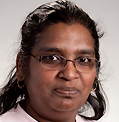3.3: Dihedral Groups (Group of Symmetries)
( \newcommand{\kernel}{\mathrm{null}\,}\)
Dihedral groups are an essential class of abstract algebra groups that arise naturally in geometry and other areas of mathematics.
Let n(≥2)∈Z Then the Dihedral group Dn is defined by Dn=<r,s|s2=e,rn=e,srs=r−1>={e,r,r2,r3,⋯,rn−1,s,rs,⋯,rn−1s} and, |Dn|=2n.
Alternatively, for n(≥3)∈Z, a dihedral group is a group of symmetries of a regular polygon with n sides. The dihedral group of order 2n, denoted by Dn, is the group of all possible rotations and reflections of the regular n sided polygon. in this case r=(1,2,3,⋯,n) represents a rotation of (360/n) degrees clockwise about the center of the polygon, and s=(1,n−1)(2,n−2)(3,n−3)⋯ represents the rotation of 180 degrees about a line through a vertex n and the center of the figure. If n is odd, s fixes only one vertex n and if If n=2m is even, s fixes vertices n and m.

Thus the group Dn consists of 2n elements, which can be depicted as follows:
- n rotations, denoted by R0,R360/n,R(360)(2)/n...,R(n−1)360/n, where Ri(360)/n represents a rotation of (360i/n) degrees clockwise about the center of the polygon, for i=1,⋯,n..
- n reflections, denoted by F0,F1,F2,...,F(n−1), where Fi represents a reflection across a line passing through the center of the polygon and one of its vertices.
All rigid motions on n-gon:
a. To replace the first vertex, we have n choices.
b. the second vertex can be replaced by kth vertex by k+1 or k−1.
The group operation in Dn, is the composition of symmetries.
Recall from chapter 2, section 2.1 Example 11
Consider the equilateral triangle below. What rigid motions can we make to it that will result in the triangle occupying the same space? What happens if we combine rigid motions? Keep in mind that "doing nothing" is also a rigid motion.
Symmetries of equilateral triangles:
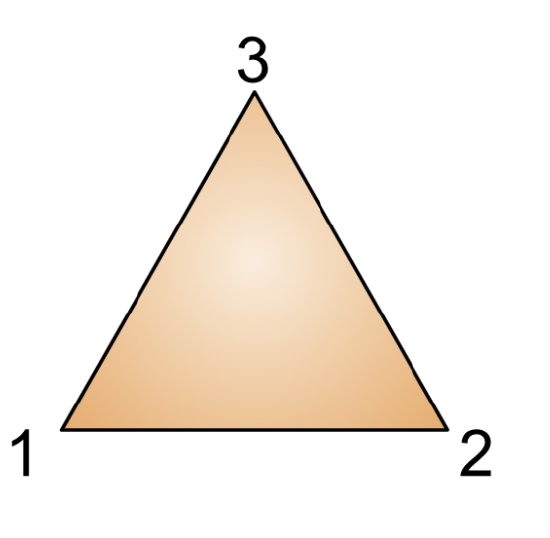
Let r be a rotation then there are three rotations I,r,r2. Let s be a reflection, then there are s,rs,r2s elements. In this case, r3=s2=I and sr=r2s. Thus D3={I,r,r2,s,rs,r2s}.
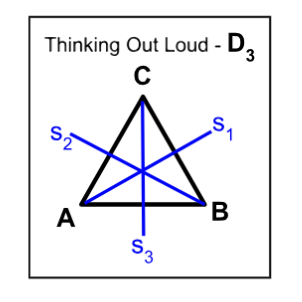 Dihedral groups Dn are non-abelian, for integers n≥3.
Dihedral groups Dn are non-abelian, for integers n≥3.
- Proof
-
Let a,b∈D3.
We will show that ab≠ba,∀a,b∈Dn,n≥3.
D3={e,(AB),(AC),(BC),(ABC),(ACB)}.
Since D3 is isomorphic to S3,D3is non-abelian.
Since D3≤Dn,∀n≥3,Dn is non-abelian for n≥3.
The Dihedral group D3 is isomorphic to S3.
Consider the possible rotations and reflections of a 4-sided regular polygon -Square, D4.
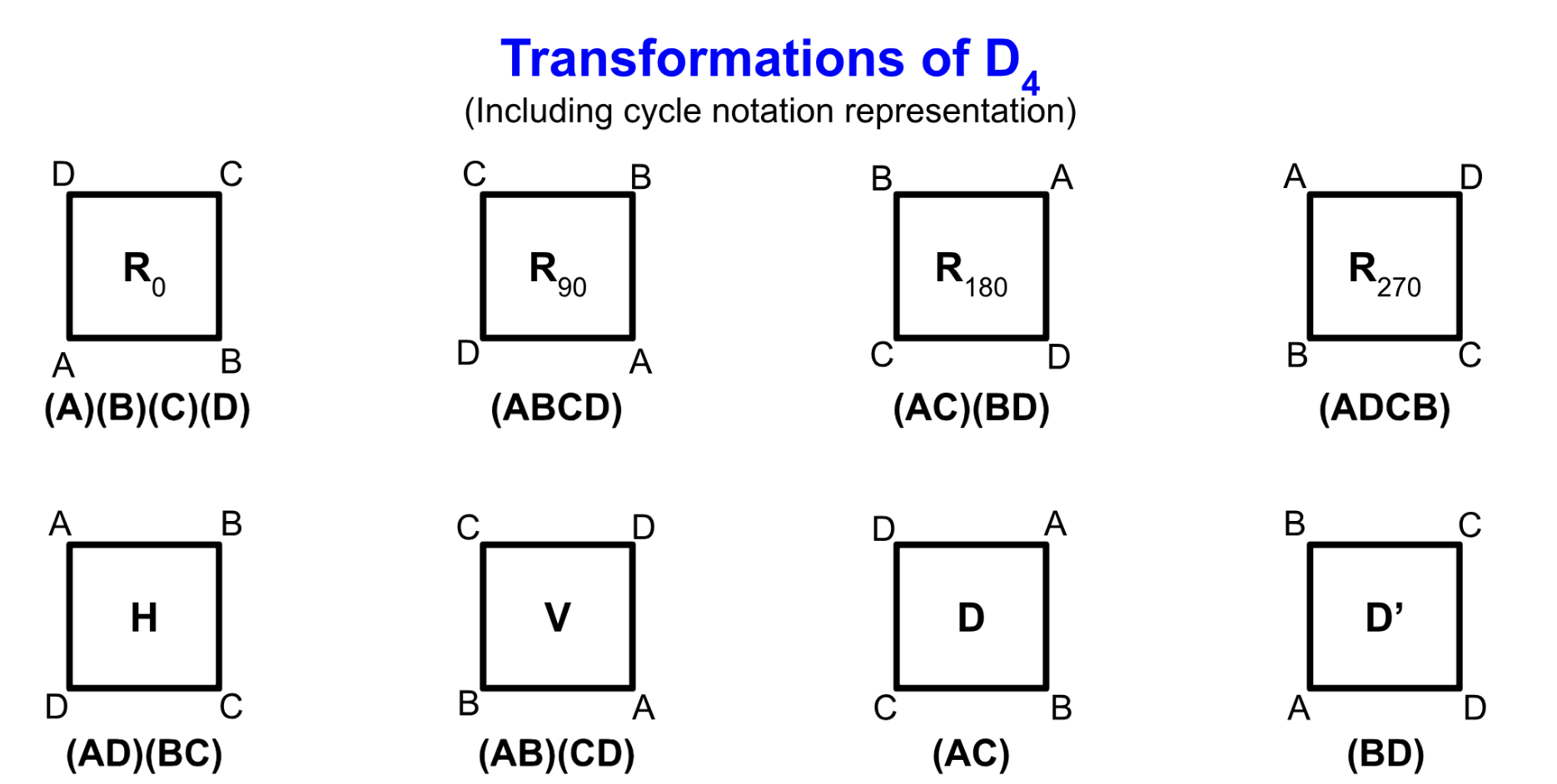
|
Cayley Table for D4 |
||||||||
|
R0 |
R90 |
R180 |
R270 |
H |
V |
D |
D’ |
|
|
R0 |
R0 |
R90 |
R180 |
R270 |
H |
V |
D |
D’ |
|
R90 |
R90 |
R180 |
R270 |
R0 |
D’ |
D |
H |
V |
|
R180 |
R180 |
R270 |
R0 |
R90 |
V |
H |
D’ |
D |
|
R270 |
R270 |
R0 |
R90 |
R180 |
D |
D’ |
V |
H |
|
H |
H |
D |
V |
D’ |
R0 |
R180 |
R90 |
R270 |
|
V |
V |
D’ |
H |
D |
R180 |
R0 |
R270 |
R90 |
|
D |
D |
V |
D’ |
H |
R270 |
R90 |
R0 |
R180 |
|
D’ |
D’ |
H |
D |
V |
R90 |
R270 |
R180 |
R0 |
D5 dihedral group of order 10, is the group of symmetries of a regular pentagon. It is composed of 10 elements, which can be represented as rotations and reflections of the pentagon.
The Cayley table for D5:
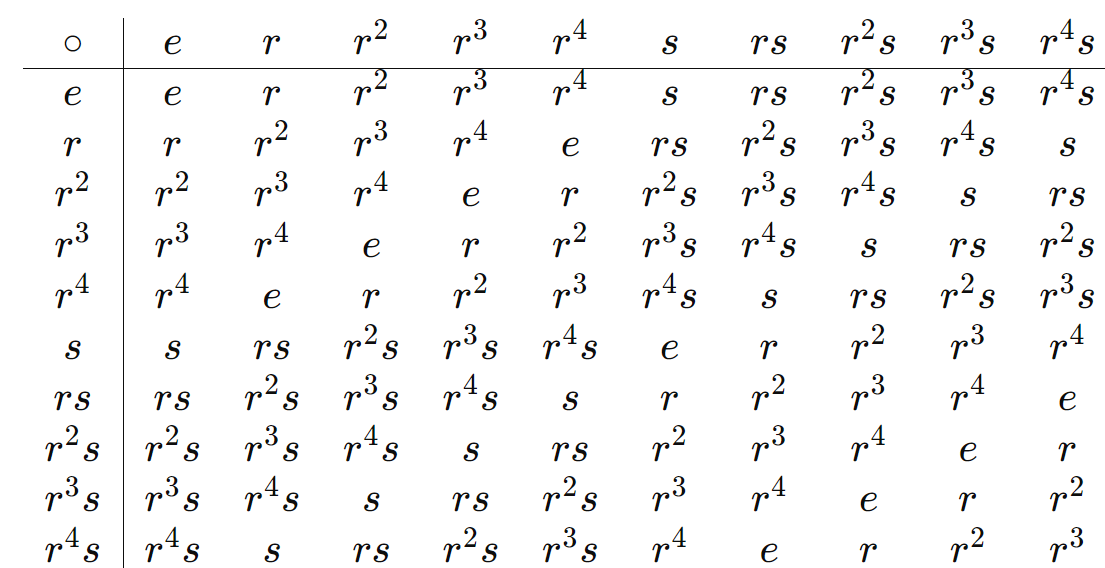
Examples abound of corporations using Dihedral groups, Dn, as their logos. Below are examples of D1,D3, and D5.

Consider the Dihedral group D4. D4=<r,s|r4=e,s2=e,srs=r−1>.
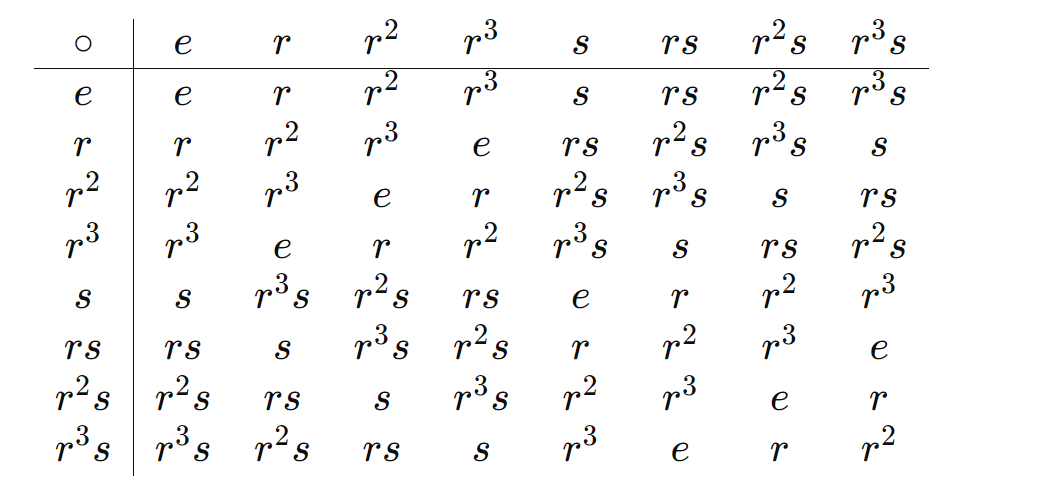
-
Find all the subgroups lattice of D4, the Dihedral group of order 8.
D4={1,r,r2,r3,s,rs,r2s,r3s}. Thus, the subgroup lattice would look like this:

Proof:
We shall show that all odd subgroups of D4 are cyclic.
The only possible odd subgroup, which is cyclic, is {e}.
Thus, every subgroup of D4 of odd order is cyclic.◻
Let the group Dn=<r,s|rn=e,s2=e,srs=r−1>.
-
Then rks=sr−k.
- Proof
-
Consider rks=erks=s2rks=ssrks=sr−k.
-
The order of rk is ngcd(k,n).
- Proof
-
We will first show that rk=e if and only if n|k.
Consider e=rk.
Then by the division algorithm, k=na+b where 0≤b<n.
Thus e=rk=rna+b=rnarb=erb=rb.
Since the smallest possible integer, m, such that rm=e is n, b=0.
Conversely, if n|k, then k=ns,s∈Z.
Thus rk=rns=(rn)s=es=e.
Thus rk=e iff n|k.
Let b=rk,∈D4 since r is a generator of Dn.
We shall show that the smallest integer, m s.t. rk=e is nk.
Let d=gcd(n,k).
Consider e=bm=rkm.
Since this is the smallest integer m such that n|km. Thus nd|m(kd).
Since d is the greatest common divisor of n and k, nd and kd are relatively prime.
Hence nd|m(kd) means that nd|m. The smallest such m is nd.
Thus |rk|=ngcd(n,k).◻
Find the centre of Dn.
Solution:
Let Dn=<r,s|rn=e,s2=e,srs=r−1>
We shall show that,
Z(Dn)={x∈Dn∣dx=xd,∀d∈Dn}={{e},if n is not divisible by 2{e,r2},if n is divisible by 2
Let's consider an element x in Dn that commutes with every other element in the group. Therefore, any element in Dn that commutes with every other element is either the identity element e or a rotation rk where k is a multiple of n/2 (for even n).
- If x is the identity element e, it commutes with every element and is in the center.
- If x is a rotation rk, where k is a multiple of n/2) (for even n), or x is the identity element e (for odd n), then it commutes with every element, and it is in the center.
- If x is a rotation rk, where k is not a multiple of n/2(for even n), then it commutes with all rotations but not with reflections. Therefore, it cannot commute with every element and is not in the center.
By combining these two statements, we can conclude that the center of Dn consists of the identity element e and the rotation rn/2 (if n is divisible by 2), or just the identity element e (if n is not divisible by 2) for even n. For odd n, the center consists only of the identity element e.


